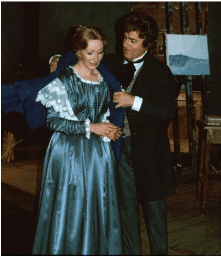Backstage to bohemian: An inside look into the evolving costumes of La bohème
by Kathleen Sykes
The stage is set: Friends gather in a metropolitan café on Christmas Eve for drinks as they have lively conversations about life, romance, philosophy, and jealousy. This scene wouldn’t be out of place in our day, even though the first performance of La bohème premiered in 1896.
The fashion icon Yves Saint Laurent once said, “Fashions fade, style is eternal.” When it comes to the costumes, this timeless classic has no shortage of style. Since our first performance of La bohème (and as a company) in 1978, this production has undergone multiple iterations ranging from a traditional staging set in the mid-1800s to a more modern one set in an ominous Paris shortly before World War II.
The costumes in each of these productions held the power to transform the characters and mood of the show. For example, in our pre-war rendition of La bohème played by Celena Shafer, Musetta, the assertive and passionate singer steals the show with a red, mermaid-style gown topped with a fur-trimmed coat and smart-looking hat.
Musetta’s sparkling personality and over-the-top aria, “Quando m’en vo’”, is enough to steal the show, but this look goes even further revealing other aspects of her story and personality. As a performer, she loves being in the spotlight—this unmissable ensemble punctuates a muted Parisian street from a France that was on the verge of war.
Even in other productions, Musetta’s personality and sense of style don’t go unnoticed. From the traditionally shocking shades of red this character wears to her incredible hats and jewels, to her unapologetic arias, this character’s performance is unforgettable.

Kathleen Thompson as Mimì and Utah Opera Founder Glade Peterson as Rodolfo in the 1978 production.
In contrast, the simple and subtle Mimí is literally the show’s “girl next door.” The ill-fated protagonist’s looks are effortless and understated, usually consisting of romantic blue dresses. Her costumes tell her story of her life as a humble seamstress even before she sings her first aria.
Take, for example, our original Mimí, played by Kathleen Thompson opposite Utah Opera Founder Glade Peterson as Rodolfo, in our very first production as a company—this soft dress with fluttering lace sleeves showcases a much quieter and romantic personality. The soft look brings emotion and character to the role and makes it even more tragic as Mimí slowly succumbs to her illness.
The path towards transformation doesn’t begin here—the ideas behind the costumes can begin a year or more in advance.
Costume Director Verona Green, who has been working in the Utah Opera costume shop for 35 years, says this journey all starts with the vision of the stage director. The costume designer and stage director will discuss all the details of the production from the time period in which it’s set and even the of the exact shade of red Musetta will wear. From there, the costume designer does extensive research on the history of the opera, the clothing of that period, and what the set will look like to determine his or her ideas.
Susan Allred, Utah Opera’s legendary costume designer whose career stretched back to our first performance of Otello in 1978, would often send her research, drawings, and fabric swatches back and forth many times to the stage director before any final designs were decided upon.
According to Ms. Green, costumes are a feature piece in the opera— they help tell the story and transform people. She says there are always challenging details of a production like what kinds of fabric they want to use to portray a time and place, or how to transform chorus members into what they need to become in that particular opera, but the final product is incredibly satisfying.
She says, “If we got the design right and got the costume to fit and saw the performer smiling, we knew we got it right. They can turn into a completely different person.”
This timeless story of romance and struggling artists still speaks to us today—and through transformative costuming, we’re brought even deeper into the story.
Can’t get enough of Musetta and Mimí? See some of the highlights of there performances here:





